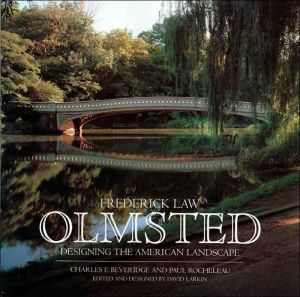Frederick Law Olmsted: Designing the American Landscape
Edited and designed by David Larkin\ \ A man of passionate vision and drive, Frederick Law Olmsted defined and named the profession of landscape architecture and designed America's most beloved parks and landscapes of the past century--New York's Central Park, Brooklyn's Prospect Park, the U.S. Capitol grounds, the Biltmore Estate, and many others. During a remarkable forty-year career that began in the mid-1800s, Olmsted created the first park systems, urban greenways, and suburban...
Search in google:
Edited and designed by David LarkinA man of passionate vision and drive, Frederick Law Olmsted defined and named the profession of landscape architecture and designed America's most beloved parks and landscapes of the past century--New York's Central Park, Brooklyn's Prospect Park, the U.S. Capitol grounds, the Biltmore Estate, and many others. During a remarkable forty-year career that began in the mid-1800s, Olmsted created the first park systems, urban greenways, and suburban residential communities in this country. He was a pivotal figure in the movement to create and preserve natural parks such as Yosemite, Yellowstone, and Niagara Falls; and he contributed to the design of many academic campuses, including Stanford University in Palo Alto, California.Today there is a resurgence of interest in Olmsted's work and legacy in both the United States and Europe. This timely volume, following the format of Rizzoli's successful Masterworks series, presents the breadth of Olmsted's work in expansive, beautiful color photographs by Paul Rocheleau, who conceived this book. The engaging text illuminates Olmsted's role as an indefatigable administrator and social reformer, a man who slept a scant few hours each night and rallied around causes ranging from anti-slavery to sanitary regulation. Olmsted's career refelected a deep concern for fostering community and using the restorative effects of natural scenery to counteract the debilitating forces of the modern city. 'Olmsted's goal was to help create an American society where all people had the qualities of gentility,' writes author Beveridge, an eminent Olmsted scholar.
Preface8Ch. 1The Years of Preparation10Ch. 2The Art of Landscape Design32Ch. 3Parks and Park Systems46Central Park, New YorkProspect Park, BrooklynThe Chicago South ParkMount Royal, MontrealBelle Isle, DetroitThe Front, Parade and Delaware Park, BuffaloThe Back Bay Fens, Riverway, Arnold Arboretum and Franklin Park, BostonGenesee Valley, Seneca and Highland Parks, Rochester, New York Shawnee, Iroquois and Cherokee Parks, Louisville, KentuckyCh. 4Residential Communities116Riverside, IllinoisSudbrook, MarylandDruid Hills, AtlantaCh. 5Academic Campuses and Residential Institutions126Lawrenceville School, New JerseyStanford University, CaliforniaHartford Retreat Buffalo State AsylumMcLean AsylumCh. 6Designing for Domesticity136Fairsted, Brookline, MassachusettsMoraine Farm, Beverly, MassachusettsCh. 7The Collaboration with H. H. Richardson175Oakes Ames Memorial Hall and Civil War Memorial Cairn, North Easton, MassachusettsLangwater Estate, North Easton, MassachusettsEphraim Gurney Estate, Beverly Farms, MassachusettsRobert Treat Paine Estate, Waltham, MassachusettsBoylston Street Bridge, BostonBoston & Albany Railroad StationsCh. 8The United States Capitol Grounds188Ch. 9Scenic Preservation200Yosemite Valley and Mariposa Big Tree GroveNiagara ReservationCh. 10Landscape Architecture for the Semiarid American West216Public Pleasure Grounds for San FranciscoMountain View Cemetery, OaklandThe College of California, BerkeleyStanford University, Palo AltoLake Wauconda, Perry Park, ColoradoCh. 11Biltmore Estate225Ch. 12The Ongoing Legacy258Public Park Systems: Seattle, WashingtonScenic Reservations: Point Lobos, CaliforniaNotes274Acknowledgments276








